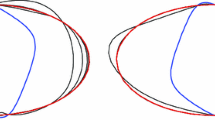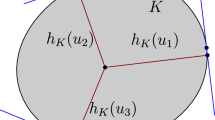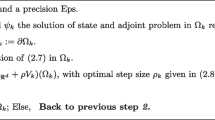Abstract
The present paper is concerned with investigating the capability of the smoothness preserving fictitious domain method from Mommer (IMA J. Numer. Anal. 26:503–524, 2006) to shape optimization problems. We consider the problem of maximizing the Dirichlet energy functional in the class of all simply connected domains with fixed volume, where the state equation involves an elliptic second order differential operator with non-constant coefficients. Numerical experiments in two dimensions validate that we arrive at a fast and robust algorithm for the solution of the considered class of problems. The proposed method can be applied to three dimensional shape optimization problems.
Similar content being viewed by others
References
Babuška, I., Banerjee, U., Osborn, J.E.: Survey of meshless and generalized finite element methods: a unified approach. Acta Numer. 12, 1–125 (2003)
Belov, S., Fujii, N.: Symmetry and sufficient condition of optimality in a domain optimization problem. Control Cybern. 26, 45–56 (1997)
Bramble, J., Pasciak, J.E., Xu, J.: Parallel multilevel preconditioners. Math. Comput. 55, 1–22 (1990)
Dahmen, W.: Wavelet and multiscale methods for operator equations. Acta Numer. 6, 55–228 (1997)
Delfour, M., Zolesio, J.-P.: Shapes and Geometries. SIAM, Philadelphia (2001)
Dennis, J.E., Schnabel, R.B.: Numerical Methods for Nonlinear Equations and Unconstrained Optimization Techniques. Prentice-Hall, Englewood Cliffs (1983)
Eppler, K., Harbrecht, H.: 2nd order shape optimization using wavelet BEM. Optim. Method. Softw. 21, 135–153 (2006)
Eppler, K., Harbrecht, H.: Exterior electromagnetic shaping using wavelet BEM. Math. Method. Appl. Sci. 28, 387–405 (2005)
Eppler, K., Harbrecht, H.: Fast wavelet BEM for 3d electromagnetic shaping. Appl. Numer. Math. 54, 537–554 (2005)
Eppler, K., Harbrecht, H.: Efficient treatment of stationary free boundary problems. Appl. Numer. Math. 56, 1326–1339 (2006)
Eppler, K., Harbrecht, H.: Coupling of FEM and BEM in shape optimization. Numer. Math. 104, 47–68 (2006)
Fiacco, A.V., McCormick, G.P.: Nonlinear Programming: Sequential Unconstrained Minimization Techniques. Wiley, New York (1968)
Fletcher, R.: Practical Methods for Optimization, vols. 1, 2. Wiley, New York (1980)
Haslinger, J., Neitaanmäki, P.: Finite Element Approximation for Optimal Shape, Material and Topology Design, 2nd edn. Wiley, Chichester (1996)
Haslinger, J., Mäkinen, R.A.E.: Introduction to Shape Optimization. Theory, Approximation and Computation. Advances in Design and Control, vol. 7. SIAM, Philadelphia (2003)
Glowinski, R., Pan, T.W., Wells, R.O. Jr., Zhou, X.: Wavelet and finite element solutions for the Neumann problem using fictitious domains. J. Comput. Phys. 126, 40–51 (1996)
Glowinski, R., Pan, T.W., Periaux, J.: A fictitious domain method for Dirichlet problem and applications. Comput. Method. Appl. Mech. Eng. 111(3–4), 283–303 (1994)
Grossmann, Ch., Terno, J.: Numerik der Optimierung. Teubner, Stuttgart (1993)
Harbrecht, H., Hohage, T.: Fast methods for three-dimensional inverse obstacle scattering. J. Integral Equ. Appl. 19(3), 237–260 (2007)
Kunisch, K., Peichl, G.: Shape optimization for mixed boundary value problems on an embedding domain method. Dyn. Contin. Discret. Impuls. Syst. 4, 439–478 (1998)
Mommer, M.S.: A smoothness preserving fictitious domain method for elliptic boundary value problems. IMA J. Numer. Anal. 26, 503–524 (2006)
Mommer, M.S.: Towards a fictitious domain method with optimally smooth solutions. Ph.D. thesis, RWTH-Aachen, published online by the RWTH-Aachen (2005)
Murat, F., Simon, J.: Étude de problémes d’optimal design. In: Céa, J. (ed.) Optimization Techniques, Modeling and Optimization in the Service of Man. Lecture Notes on Computer Science, vol. 41, pp. 54–62. Springer, Berlin (1976)
Neitaanmäki, P., Tiba, D.: An embedding of domain approach in free boundary problems and optimal design. SIAM J. Control Optim. 33, 1587–1602 (1995)
Novruzi, A., Roche, J.R.: Newton’s method in shape optimisation: A three-dimensional case. BIT 40, 102–120 (2000)
Paige, C.C., Saunders, M.A.: LSQR: An algorithm for sparse linear equations and sparse least squares. ACM Trans. Math. Softw. 8, 43–71 (1982)
Pierre, M., Roche, J.-R.: Numerical simulation of tridimensional electromagnetic shaping of liquid metals. Numer. Math. 65, 203–217 (1993)
Pironneau, O.: Optimal Shape Design for Elliptic Systems. Springer, New York (1983)
Roche, J.-R., Sokolowski, J.: Numerical methods for shape identification problems. Control Cybern. 25, 867–894 (1996)
Simon, J.: Differentiation with respect to the domain in boundary value problems. Numer. Funct. Anal. Optim. 2, 649–687 (1980)
Slawig, T.: Domain optimization for the stationary Stokes and Navier–Stokes equations by an embedding domain technique, Ph.D. thesis, TU Berlin (1998)
Slawig, T.: A formula for the derivative with respect to domain variations in Navier–Stokes flow based on an embedding domain method. SIAM J. Control Optim. 42, 495–512 (2003)
Sokolowski, J., Zolesio, J.-P.: Introduction to Shape Optimization. Springer, Berlin (1992)
Author information
Authors and Affiliations
Corresponding author
Rights and permissions
About this article
Cite this article
Eppler, K., Harbrecht, H. & Mommer, M.S. A new fictitious domain method in shape optimization. Comput Optim Appl 40, 281–298 (2008). https://doi.org/10.1007/s10589-007-9076-2
Received:
Revised:
Published:
Issue Date:
DOI: https://doi.org/10.1007/s10589-007-9076-2




